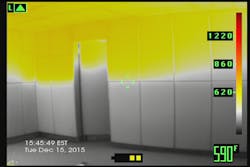Thermal imaging cameras (TICs) have become an essential part of our equipment and could be considered a part of our PPE. In May 2001, fire service legend Francis Brannigan stated, “The thermal imaging camera should not be an afterthought. It should be thought of as an immediate tool that is as necessary as the nozzle. It should be used to determine on the first attack whether the hazard of burning trusses or I-beams is overhead or in the floor.” I think Brannigan was on to something. In this article, we will discuss four types of searches and the benefits of the TIC in each. But let’s first discuss some basics about searching with a TIC.
Search basics
Think of each room as a compartment. The compartment has seven sides, and each is important. The top or ceiling is where we look for heat signatures and learn to cool the environment as we go. The floor is where we look for holes or fire below. Pooled water can mimic a hole in the floor so I throw a golf ball into the area to check for movement of the source. There are four walls that we check for egress, room familiarization and conditions behind us. Look for doors, windows and contents, and remember where they are.
What is the seventh side? The inside. Here is where we look at the room thermally. What are the conditions in the room itself? Is it over 500 degrees? Do we need to condition it before moving through it? What is the current flow path? What is the temperature of the room contents? Remember that thing called pyrolysis?
You will be able to use the TIC to see the temperatures of the room contents and cool them as you go to prevent ignition. Remember, we are looking for victims and fire. Search all areas that the TIC cannot see. Some examples of these areas include closets, under the bed, on the opposite side of furniture, and in bathtubs. When searching with a TIC, certain items may insulate the heat a victim is giving off, and you may not see the thermal signature of a person. You may instead see a big pile on top of a bed; this could be a child under the blankets. Learn to look for anomalies as well as thermal signatures. If something does not look right, investigate.
Now that we’ve tackled the basics, let’s review four types of searches with a TIC.
1. Point-to-point search
We have learned that the attack team usually locates the victims on the way to the fire, as their egress is usually our access. A point-to-point search is the most efficient way to locate the fire room. This search is performed by using the TIC to find where the heat is located. We should have a general idea from using our TIC on a size-up, then going straight to it. The fastest way between two points is a direct line, and we all know that time is not on our side in these modern-day fires.
2. TIC-lead search
In a TIC-lead search, the front firefighter has the imager and assesses the room. They decide whether to move on or investigate the room. If they are going to investigate a room, the crew stays by the door while the firefighter with the TIC performs the search. This is a rapid method of search, as you only need to check the areas where the TIC cannot see. A problem with this search is that the TIC firefighter may forget that they are the only one who can see and will take off, leaving their crew behind. Good communication is always needed, and remember to give directions and pass on information to your crew.
3. TIC-directed search
In a TIC-directed search, the front firefighter scans the room and then gives the information to the crew. The crew then searches the areas of which they are informed that the TIC cannot see. The TIC firefighter stays at the door and watches conditions and directs the crew. An advantage of this is that your TIC is monitoring the firefighters and the conditions for safety. If it gets bad in the hall, get into the room and shut the door. This search is time-consuming and communication-dependent.
4. Vent-Enter-Isolate-Search (VEIS)
This search can be used with one or two TICs. With one TIC, the TIC firefighter scans the area of entry. Look for heat signatures on the roof, in the walls, and on the window frames. If clear, continue with your VEIS procedures. When you open the window, use the TIC to check conditions using the seven-side size-up. Make entry, close the door to the room, and search the areas you were not able to see in the TIC. This would be a TIC-lead search in VEIS. If you have two firefighters with a TIC, the other firefighter would monitor conditions from the ladder and work as a second set of eyes to guide the lead firefighter on whatever areas they may have missed.
Enhancing knowledge
These four searches are similar, and each is used to improve efficiency, safety and time. In his paper “Maximising Thermal Imaging Use in the Emergency Services,” Michael Whitty from the Metropolitan Fire Brigade in Melbourne, Australia, shares research that proves the value of TICs. Specifically, his research showed a 75 percent reduction in time to locate victims or downed firefighters in a fire with using a TIC. That’s time we would appreciate regardless of what side of the TIC we were on.
Learn how to use your thermal imager like you know your irons. The more you know what your cell phone can do, the more helpful it is. The thermal imager is no different. But never forget a key principle: The TIC enhances your knowledge, but it does not replace it.
Reference
Whitty, M. “Maximising Thermal Imaging Use in the Emergency Services.” 2010. Metropolitan Fire Brigade in Melbourne, Australia. http://fire-safety-for-all.sustainable-design.ie/wp-content/uploads/2016/09/TIC_Maximizing-Use-in-Emergency-Services_Whitty-MFB_2010.pdf

Joseph DeVito
Joseph DeVito is a captain in Florida who has more than 25 years in public service. He has worked at volunteer organizations and as an EMT-P for a county-run EMS department and has been at his current department for 18 years. DeVito is Level 1 IR-certified and holds the Fire Officer credential from the Center for Public Safety Excellence. He loves teaching thermal imaging, which is a tool that he believes is under-utilized in the fire service.






